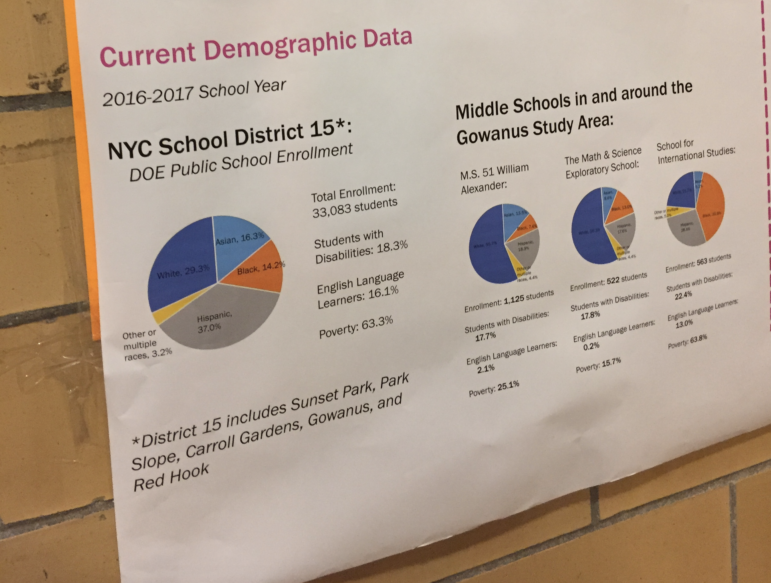
Abigail Savitch-Lew
A poster at the Gowanus study open house on schools, transportation and community resources (Thursday October 19)
As City Limits reported on Wednesday, the Department of City Planning just released a list of “working group recommendations” developed throughout the year by stakeholders in Gowanus. The neighborhood is one of the ten communities where a neighborhood rezoning is being considered or has been adopted as part of the mayor’s affordable housing plan. Yet because those recommendations did not touch on two key factors of neighborhood planning—schools and transportations—an open house was convened on Thursday to explore those topics.
As a few attendees pointed out, it can be difficult to plan or speculate about the neighborhood’s future needs given the great uncertainty about what that future will hold. Nevertheless, certain themes emerged, both ones heard in most rezoning neighborhoods and ones more unique to Gowanus. Here are some key takeaways.
District 15 already crowded – While certain areas are more crowded than others, the district overall, which includes Sunset Park, Park Slope, Carroll Gardens, Gowanus, and Red Hook faces a shortage of seats already, and funding has been set aside in the 2015-2019 capital budget for almost 3,400 new seats in and around the Gowanus study area. Because no exact rezoning strategy has yet been proposed, it is impossible to say how many more seats the area will need in the event of a rezoning.
School integration is key goal – District 15 is 29.3 percent white, but a couple of the most sought-after middle schools in the district are well over 50 percent white, while others have high concentrations of low-income students of color. Some public housing residents in Gowanus have also expressed concerns that they are being crowded out of their zoned schools by wealthier parents moving into the district.
There are already several efforts underway to address the issue, including Diversity in Admissions, a citywide pilot program that allows schools that opt-in to prioritize the admission of low-income students; a couple schools in district 15 are already participating. (Lander has previously expressed a desire to expand that policy to every school in his district.) In addition, the Department of Education and neighborhood stakeholders have launched a new initiative, the D15 Diversity Plan, that will convene a working group to deliberate on future district-wide changes. It’s not entirely clear how a rezoning would change school demographics or how the planning process can be used to further integration, but on Thursday Lander said it was one of his priorities. “If we had a more integrated neighborhood, that would be a great opportunity to have more integrated schools as well,” Lander told the room.
Bring back the B71 – The bus service was cut during the recession. Lander, the Fifth Avenue Committee and others are spearheading a campaign to bring it back and are also advocating for its connection to downtown Manhattan via the Brooklyn-Battery Tunnel. The service is especially crucial for residents of public housing residents and residents in Red Hook’s transit desert. (In contrast, we saw a couple negative post-its indicating people’s disinterest in the Brooklyn-Queens Connector project, a streetcar that would connect Astoria to Sunset Park.)
Lack of accessible transit – In addition to the B71 bus, Aronowsky said the area lacks ADA-compliant subway stations. The Smith-9th Street station was recently renovated but doesn’t include elevators, for instance.
Alternatives to trucks – In the event of a rezoning, it’s foreseeable that conflict between truck traffic and more residents could be a substantial issue. One poster brought by city staff discussed two initiatives underway that will aim to reduce truck traffic and accidents and make trucks cleaner: the Department of Transportation’s ongoing development of a Smart Truck Management Plan, and the Economic Development Corporation’s FreightNYC initiative, to strengthen the freight sector. There’s even talk of exploring an expansion of cargo bikes.
A victory for Gowanus Houses – Attendees celebrated the news that the mayor had agreed to one of the most widely supported working group recommendations: to fund the reopening of the Gowanus Community Center. Gowanus Houses Resident association President Edward Tyre expressed gratitude to all those who had fought alongside Gowanus Houses residents as well as optimism about the planning process overall and the ways he felt the neighborhood was finally beginning to come together as one. “They’re starting to accept us as part of the community,” he said. (According to DNAinfo, the city still needs to find a nonprofit organization to run the space and renovations might take until 2021.)
A variety of reactions – During the open house, we also asked attendees to comment on the working group recommendations. Sabine Aronowsky of the Fifth Avenue Committee, said many of the Gowanus Neighborhood Coalition for Justice’s demands have still not been adopted, including a commitment to use value-capture mechanisms to ensure profit from development goes to repairing NYCHA buildings and including the Industrial Business Zone in the rezoning study (industrial advocates would like to see an increase in manufacturing density in the IBZ.) One resident expressed strong concerns about building in a flood zone, and another that the investments in the area would only help developers sell their new buildings and exacerbate gentrification. We also spoke with three people in real estate and development, each of whom said they were hoping for high residential densities, though certainly with space for other community and commercial amenities.








One thought on “Schools, Transit and Race: Gowanus has More Than a Rezoning on its Mind”
There simply aren’t enough white students to spread around anymore. The NYC public schools are 14.88% white, Brooklyn schools are only 17.26% white. Even Staten Island is down to 46.75% white.
Borough | % White | white + asian %
Bronx | 4.29% | 8.9%
Brooklyn | 17.26% | 33.20%
Manhattan | 16.13% | 28.2%
Queens | 13.00% | 41.2%
Staten Island | 46.75% | 55.60%
http://schools.nyc.gov/NR/rdonlyres/77954FB0-FD24-476B-AB81-3E9BBE8655D9/213559/DemographicSnapshot201213to201617Public_FINAL1.xlsx